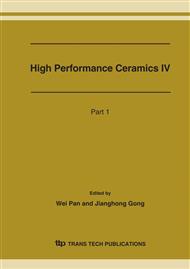[1]
L. T. Canham: Appl. Phys. Lett. Vol. 57 (1990), p.1046.
Google Scholar
[2]
N. Koshizaki, H. Umehara and T. Oyama: Thin Solid Films Vol. 325 (1998), p.130.
Google Scholar
[3]
A. R. Wilkinson and R. G. Elliman, J. Appl. Phys. Vol. 96 (2004), p.4018.
Google Scholar
[4]
R. Tohmon, R. Shimogaichi, S. Munekuni, et al.: Appl. Phys. Lett. Vol. 54 (1989), p.1650.
Google Scholar
[5]
B.T. Poe, P.F. McMillan, C.A. Angell and R.K. Sato: Chem. Geol. Vol. 96 (1992), p.333.
Google Scholar
[6]
H. R. Philipp: J. Non-Cryst. Solids Vol. 8-10 (1972), p.627. Fig. 4 Si 2p core-level spectra of the SRA films annealed at 900°C under (a) vacuum and (b) O2 atmosphere for 120 min. The bold full curve is the result of a least-square fit. Individual peaks in the fits are drawn in dash lines and designated in integers corresponding to the number of Si-O bonds. The 4' peak is a composed peak from Si4+ in aluminosilicate and Si3+ species.
Google Scholar


